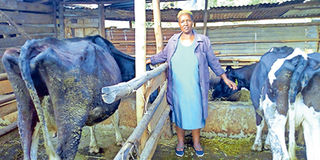Small dairy farm with moo lessons

Bibian Mutavi on her dairy farm in Makueni. The farm has become an attraction to farmers in the region in which zero-grazing is fast-picking up thanks to large-scale growing of fodder grass that include Boma Rhodes. PHOTO | FAITH NYAMAI | NMG
What you need to know:
- The farm has become an attraction to farmers in the region in which zero-grazing is fast-picking up thanks to large-scale growing of fodder grass that include Boma Rhodes.
- The cattle structure has a feeding place, a milking parlour and each of the animals has a sleeping quarter.
- The farmer has planted Boma Rhodes grass, from which she makes hay for her animals. Her farm also hosts napier grass.
- Vaccination of the young ones against various diseases is done a month after birth.
On the outskirts of Barazani trading centre in Mutiswa village in Makueni County sits a model dairy farm named Mukalu.
The farm has become an attraction to farmers in the region in which zero-grazing is fast-picking up thanks to large-scale growing of fodder grass that include Boma Rhodes.
We find Bibian Mutavi, the owner of the farm, attending to one of her 10 Friesian dairy cows.
“I fell in love with farming four years ago and since then, I spend most of my time on the farm, especially when schools are closed, feeding cows and preparing their feeds,” says Bibian, a primary schoolteacher.
On the 10 acres, Bibian also plants different kinds of vegetables that include tomatoes, onions, capsicum, sukuma wiki and cabbages.
But it is their dairy farm where her heart is because this is her cash cow.
“I started with two Friesian cows that cost me Sh140,000, part of Sh500,000 loan that I borrowed from our sacco,” she recounts, adding part of the cash also went to the cowshed and feeds.
The cattle structure has a feeding place, a milking parlour and each of the animals has a sleeping quarter.
The structure is cleaned daily to prevent the animals from contracting diseases.
“We feed the cows three times a day, in the morning at 5am, at noon and in the evening at 6pm,” says Bibian, who started farming in 2015.
The farmer has planted Boma Rhodes grass, from which she makes hay for her animals. Her farm also hosts napier grass.
She mixes the grass with sukuma wiki or cabbages and green maize plants and molasses from her farm before offering the animals.
“I also give them concentrates, fish meal and sunflower to ensure they get a balanced diet.”
Each of the animals has a name that comes in handy during vaccination, breeding and while keeping general records.
SPREAD SAND IN SLEEPING QUARTERS
“I have engaged a veterinary doctor who ensures a cow is inseminated six months after delivery, I then continue milking for six more months before their time to calve down comes,” she reveals one of her secrets.
Vaccination of the young ones against various diseases is done a month after birth.

An employee milks dairy cattle in Bibian's Makueni dairy farm. She sells the milk at Sh70 a litre to eateries at a nearby market and her school, earning a tidy sum every day. PHOTO | FAITH NYAMAI | NMG
She also deworms them after every three months and maintains regular spraying against ticks.
She uses a machine to milk the cows, noting it increases yields from her animals and reduces stress throughout the lactation period.
“The machine helps us to keep the teats free of diseases like mastitis because we are able to maintain high standards of hygiene,” John Musembi, her worker offers.
Each cow, says Musembi, produces between 20 and 30 litres of milk a day.
“We do the milking twice a day, at 6am and 6pm. Currently, we are milking three cows. Two of our animals are almost delivering, therefore, we are going to have more milk,” he says, noting he milks 75 litres of milk a day.
Bibian sells the milk at Sh70 a litre to eateries at a nearby market and her school, earning a tidy sum every day.
On average, she receives up 20 farmers a month, who visit for lessons. She does not charge them but they buy farm produce such as sukuma wiki, cabbages, tomatoes and onions.
Bibian further supplies produce from her crop farm, namely vegetables, maize, tomatoes and cabbages farm to traders in Sultan Hamud, Kathozweni, Salama, Kasikeu and Emali towns.
Felix Opinya, a dairy specialist at Egerton University, says to increase milk output, feeds must have 16 per cent crude protein.
“If possible, farmers should spread sand in the cow’s sleeping quarters as it provides good comfort, which also increases milk production.”





